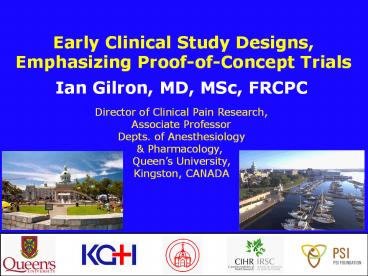Early Clinical Study Designs, Emphasizing Proof-of-Concept Trials - PowerPoint PPT Presentation
Title:
Early Clinical Study Designs, Emphasizing Proof-of-Concept Trials
Description:
... Falsely negative POCT - could be missing out on a potentially promising and effective treatment 2) Falsely positive POCT ... – PowerPoint PPT presentation
Number of Views:45
Avg rating:3.0/5.0
Title: Early Clinical Study Designs, Emphasizing Proof-of-Concept Trials
1
Early Clinical Study Designs, Emphasizing
Proof-of-Concept Trials
Ian Gilron, MD, MSc, FRCPC Director of Clinical
Pain Research, Associate Professor Depts. of
Anesthesiology Pharmacology, Queens
University, Kingston, CANADA
2
TREATMENT EFFICACY Divergent dilemmas in the
development of new therapies
1) Falsely negative POCT - could be missing out
on a potentially promising and effective
treatment 2) Falsely positive POCT - could be
"fished in" to devoting substantial resources on
an ultimately unmarketable therapy Q What
investigative approaches can minimize risk of
the above two problems?
3
Questions - old new - for POC trials
1. Do human experimental pain studies reliably
predict clinical treatment responses? 2. What
is the value of surrogate outcomes for
POCTs? 3. Which trial methods optimize
predictive value? 4. Do active comparators
improve predictive value? 5. When how do PK
measures need to be incorporated into early
efficacy studies?
4
Pre clinical RCTs to predict disease
responsiveness Can experimental- predict clinical
treatment responses? A case study of gabapentin
Model/condition Efficacy? Reference
1stº burn Werner et.al., 2001
UV-B injury - Gustorff et.al., 2004
capsaicin-hyperalgesia Gottrup et.al., 2004
capsaicin-hyperalgesia - Iannetti et.al., 2005
IM hypertonic saline Arendt-Nielsen et.al., 2007
IM hypertonic saline - Segerdahl, 2006
electrical stimulation Arendt-Nielsen et.al., 2007
electrical stimulation Segerdahl, 2006
5
RCTs to understand treatment mechanisms in humans
activation
Iannetti et. al., PNAS 2005
deactivation
6
Comparing to the moving placebo target Which is
the true result?
plt0.01, Pgb 300mg/d vs. placebo
Rosenstock et al., Pain 2004.
NS, Pgb 300mg/d vs. placebo
Tolle et al., Eur. J. Pain 2008.
7
Does more stringent blinding improve predictive
value?
Diazepam reduced unpleasantness of but NOT
sensory intensity of pain following tooth pulp
electrical stimulation (Gracely et. al., 1982)
Benzodiazepines also shown to be ineffective for
neuropathic pain (Max et. al., 1988 Dellemijn
et. al., 1997) Benzodiazepines subsequently
used as an active placebo to improve blinding
in several analgesic trials (Gilron et. al.,
2000 Sang et. al., 2002 Rorarius et. al., 2004
Gilron et. al., 2005) Q How to best match
active placebo to study treatment? Q How to
interpret POCT results in light of blinding
questionnaire data?
Gracely et. al., Anesth Analg 1982
8
Innovative designs to improve analgesic
evaluation Can RCTs deal with heterogeneous
populations?
Byas-Smith et. al., Pain 1995
9
Innovative designs to improve analgesic
evaluation Can RCTs deal with heterogeneous
populations?
Byas-Smith et. al., Pain 1995
See also review by McQuay et al., Pain 2008
10
Is enriched enrollment good? or bad? for
the predictive value of POCTs?
exclude placebo responders? exclude
treatment non-responders? exclude extremes of
pain intensity upon study entry? exclude
subjects with psychopathology?
11
Do active comparators improve predictive value?
clinically relevant validates trial
methods requires available Txs
Dionne et. al., 98.
12
PK for early efficacy studies?
Sindrup et. al., Pain. 1990 Aug42(2)135-44.
13
POCTs as a diagnostic test of efficacy
phase 3 RCT outcome -
POCT outcome -
true positive false positive
false negative true negative
Sensitivity a/(a c) Specificity d/(b
d) ve pred. value a/(a b) -ve pred. value
d/(c d)
a b c d
False negative - could be missing out on a
promising treatment False positive - "fished in"
to spending on a failed therapy Q Can
retrospective analysis of studies on recently
marketed drugs identify methods with high
predictive value?
14
DISCUSSION
Previous research on pain therapies has
nurtured the development of diverse investigative
methods tools. The optimally predictive,
safe, inexpensive and efficient approach to a
proof-of-concept trial program likely needs to be
individualized to the treatment and target
condition. Given the prospective nature of
development programs (i.e. phase I, then II, then
III) it may be impossible to identify the
perfect POC trial design. Inclusion of at
least one active comparator with known efficacy
(in addition to placebo), multiple outcome
measures, and concurrent PK measures could
greatly aid in interpretation of POCT results.
Retrospective analysis of POCTs of currently
licensed treatments could provide useful
information about POCTs with optimal predictive
value.































